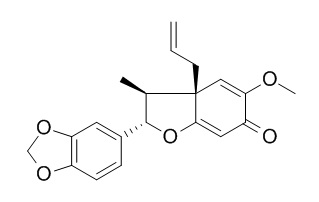Burchellin
Burchellin has larvicidal activity, it can interfer with the development cycle of the mosquito, where its strongest toxic effect is 100% mortality in larvae (L3) at concentrations ≥ 30 ppm. Burchellin and licarin A have activity against Trypanosoma cruzi, they can induce trypomastigote death with IC(50)/24 h of 520 microM and 960 microM, respectively.
Inquire / Order:
manager@chemfaces.com
Technical Inquiries:
service@chemfaces.com
Tel:
+86-27-84237783
Fax:
+86-27-84254680
Address:
1 Building, No. 83, CheCheng Rd., Wuhan Economic and Technological Development Zone, Wuhan, Hubei 430056, PRC
Providing storage is as stated on the product vial and the vial is kept tightly sealed, the product can be stored for up to
24 months(2-8C).
Wherever possible, you should prepare and use solutions on the same day. However, if you need to make up stock solutions in advance, we recommend that you store the solution as aliquots in tightly sealed vials at -20C. Generally, these will be useable for up to two weeks. Before use, and prior to opening the vial we recommend that you allow your product to equilibrate to room temperature for at least 1 hour.
Need more advice on solubility, usage and handling? Please email to: service@chemfaces.com
The packaging of the product may have turned upside down during transportation, resulting in the natural compounds adhering to the neck or cap of the vial. take the vial out of its packaging and gently shake to let the compounds fall to the bottom of the vial. for liquid products, centrifuge at 200-500 RPM to gather the liquid at the bottom of the vial. try to avoid loss or contamination during handling.
Viruses2023, 15(6), 1377
Chem Pharm Bull (Tokyo).2019, 67(11):1242-1247
Cell Rep.2022, 39(1):110643.
Int J Mol Sci.2015, 16(8):18396-411
Industrial Crops and Products2024, 219:119123
Drug Dev Res.2020, doi: 10.1002
Front Pharmacol.2020, 11:683.
Anat Rec2018, 24264
J Pharm Biomed Anal.2018, 151:32-41
Enzyme Microb Technol.2022, 153:109941.
Related and Featured Products
Parasit Vectors. 2014 Apr 8;7:172.
Burchellin: study of bioactivity against Aedes aegypti.[Pubmed:
24713267]
The dengue mosquito Aedes aegypti Linnaeus, 1762 is a widespread insect pest of serious medical importance. Since no effective vaccine is available for treating dengue, the eradication or control of the main mosquito vector is regarded as essential. Since conventional insecticides have limited success, plants may be an alternative source of larvicidal agents, since they contain a rich source of bioactive chemicals. The aim of this study was to evaluate the larvicidal activity of the neolignan Burchellin isolated from Ocotea cymbarum (Lauraceae), a plant from the Amazon region, against third instar larvae of A. aegypti.
METHODS AND RESULTS:
Burchellin obtained from O. cymbarum was analyzed. The inhibitory activity against A. aegypti eggs and larvae and histological changes in the digestive system of treated L3 larvae were evaluated. In addition, nitric oxide synthase activity and nitric oxide levels were determined, and cytotoxicity bioassays performed.
The data showed that Burchellin interfered with the development cycle of the mosquito, where its strongest toxic effect was 100% mortality in larvae (L3) at concentrations ≥ 30 ppm. This compound did not show target cell toxicity in peritoneal macrophages from BALB/c mice, and proved to have molecular stability when dissolved in water. The L3 and L4 larvae treated with the compound showed cellular destruction and disorganization, cell spacing, and vacuolization of epithelial cells in small regions of the midgut.
CONCLUSIONS:
The neolignan Burchellin proved to be a strong candidate for a natural, safe and stable phytolarvicidal to be used in population control of A. aegypti.
Exp Parasitol. 2010 Mar;124(3):319-24.
Neolignans from plants in northeastern Brazil (Lauraceae) with activity against Trypanosoma cruzi.[Pubmed:
19944690 ]
Trypanosoma cruzi is the ethiological agent for Chagas disease in Latin America. This study aimed to test the trypanocidal effect of licarin A and Burchellin isolated from plants in northeastern Brazil.
METHODS AND RESULTS:
These neolignans were tested on T. cruzi and on peritoneal macrophages, to evaluate drug toxicity. Epimastigote growth was inhibited in 45% with licarin A and 20% with Burchellin with an IC(50)/96 h of 462.7 microM and 756 microM, respectively. Epimastigotes treated with licarin A presented swollen mitochondria and disorganized mitochondrial cristae, kDNA and Golgi complex. When treated with Burchellin, they presented enormous autophagosomes and chromatin disorganization. Licarin A and Burchellin were able to induce trypomastigote death with IC(50)/24 h of 960 microM and 520 microM, respectively. Although licarin A presented an IC(50) for trypomastigotes higher than for epimastigotes, both substances acted as therapeutic trypanocidal agents, because they were able to kill parasites without affecting macrophages.
CONCLUSIONS:
Due to our results, Burchellin and licarin A need to be further analysed to observe if they may be used as alternative blood additive prophylaxis against Chagas disease, since it has been established that blood transfusion is an important mechanism in the transmission process.



